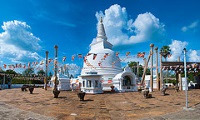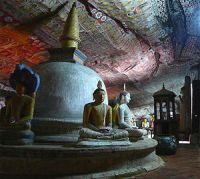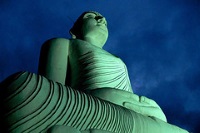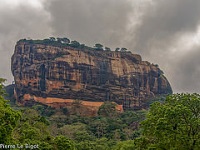
The remains of the ancient city of Anuradhapura are situated about 130 miles (205km) north of Colombo, standing majestically in the jungle that for generations hid away the palaces, monasteries and monuments, which have been there since the third century BC. The ancient city was capital of the island for more than 10 centuries, until an invasion in the year 993; the city is said to have been founded around a fig tree grown from a cutting of Buddha's 'tree of enlightenment'.The remains visible today consist of several magnificent dagobas (domes built to enshrine sacred relics), sculptures, carvings, ruined palaces and monasteries, bathing ponds and irrigation tanks. The city once had one of the most complex irrigation systems of the ancient world and the reservoir tanks still visible today are some of the oldest surviving in the world. Since the rediscovery of the ancient, ruined city by the British in the 19th century, Anuradhapura has been a Buddhist pilgrimage site as well as an attraction for travellers.Thought to be the oldest surviving historical tree in the world, the Jaya Sri Maha Bodhi is said to be a sapling from the tree under which Buddha attained enlightenment. The tree was planted in 288 BC, on a high terrace roughly 21 feet (6.5m) above the ground, and is surrounded by a prayer flag-festooned wall built by King Kirthi Sri Rajasingha to protect it from wild elephants. Located in Anuradhapura, the Sri Maha Bodhi is a pilgrimage site for thousands of Buddhist devotees who come to make offerings during the full moon. Visitors must remove shoes and hats before entering the site.Tourist facilities and hotels are available in the nearby 'new town' of Anuradhapura. A recommended way to view the many scattered archaeological treasures is to hire a bicycle, or travel between sights on a tuk-tuk.
Opening times : Daily 8am-5pm.

Sri Lanka's Buddhist heritage is nowhere as evident as in the Golden Temple of Dambulla, a UNESCO World Heritage Site. A sacred pilgrimage site for 22 centuries, this cave-temple is the best preserved of its kind in Sri Lanka. The temple encompasses five separate caves, each housing ancient statues and artwork of the Buddha. The statues vary in size up to 50 feet (15m) tall and there are also incredible painted murals on the walls.The largest cave, the Cave of the Great Kings, holds 56 statues, and others dedicated to Hindu gods such as Vishnu and Saman dating back to the 12th century. Another cave has more than 1,500 paintings covering the ceiling. The temples and caves are one of Sri Lanka's most spectacular tourist attractions, and are attached to a functional monastery dating back to the third century BC.The site also includes evidence of human occupation going back to the prehistoric period. Lots of monkeys frequent the temple complex and they can be cute and entertaining, but tourists should treat the animals with respect as they can and will bite if they feel threatened. The climb to the caves can be tiring, especially in the heat, and may not be manageable for people with mobility issues.

The relaxed and peaceful atmosphere of Kandy, in the heart of Sri Lanka's hill country, is probably the result of being beautifully situated around a tranquil lake in a bowl of hills. It is a colourful, unique city, which resisted Portuguese and Dutch colonisation for three centuries before finally succumbing to the British. The town is the bastion of the island's pervasive Buddhist faith, and plays host to the country's most venerated religious relic, the sacred tooth of Buddha.The octagonal Dalada Maligawa, or Temple of the Tooth, attracts hundreds of pilgrims to daily ceremonies honouring the relic, and each year in July and August the tooth is carried in procession on an elephant during the ancient Esala Perahera parade. According to legend, the tooth was taken from Buddha as he lay on his funeral pyre and was smuggled to Sri Lanka hidden in the hair of a princess in the 4th century. Visitors can't actually see the tooth as it's in a casket, but the temple is an interesting place all the same. The ancient city also sports a good museum, the lovely Peradeniya Botanical Gardens, a bird sanctuary and an auditorium where folk dances are performed and local crafts are on display. Kandy has a cooler, milder climate than much of Sri Lanka due to its altitude.
Website : www.kandycity.org

Sigiriya is an important Buddhist site in central Sri Lanka, about 100 miles (161km) northeast of Colombo. The remains of an ancient royal fortress and city dating from 477 AD stand on a vast rock, which rises 600ft (180m) above the surrounding plain. King Kasyapa built it to safeguard against attack from his brother, Mogallana from whom he had stolen the throne after having killed their father.The only way into the city is through the massive carved jaws of a lion - the name Sigiriya is taken from 'giriya', meaning 'jaws and throat' and 'sinha' meaning 'lion'. The site is one of the best-preserved first-millennium city centres in Asia and is also renowned for its 5th-century rock paintings and its magnificent, symmetrical water gardens. Visitors should note that getting to the flat summit and fortress requires climbing about a thousand steps, and it is a good idea to bring plenty of water and to avoid doing the climb at the hottest time of day.There is a museum, outside the main entrance, housing some artefacts from the site, reproductions of some of the art, and photos of the excavation process. Sigiriya is an expensive attraction by Sri Lankan standards, but it is a remarkable and fascinating place and undoubtedly one of the country's greatest historical treasures.

Travel Guide powered by Word Travels, copyright © 2023 Globe Media Ltd. By its very nature information in this travel guide is subject to change at short notice and travellers are urged to verify information on which they're relying with the relevant authorities. Neither Globe Media Ltd nor Travel Vogue can accept any responsibility for any loss or inconvenience to any person as a result of information contained above.